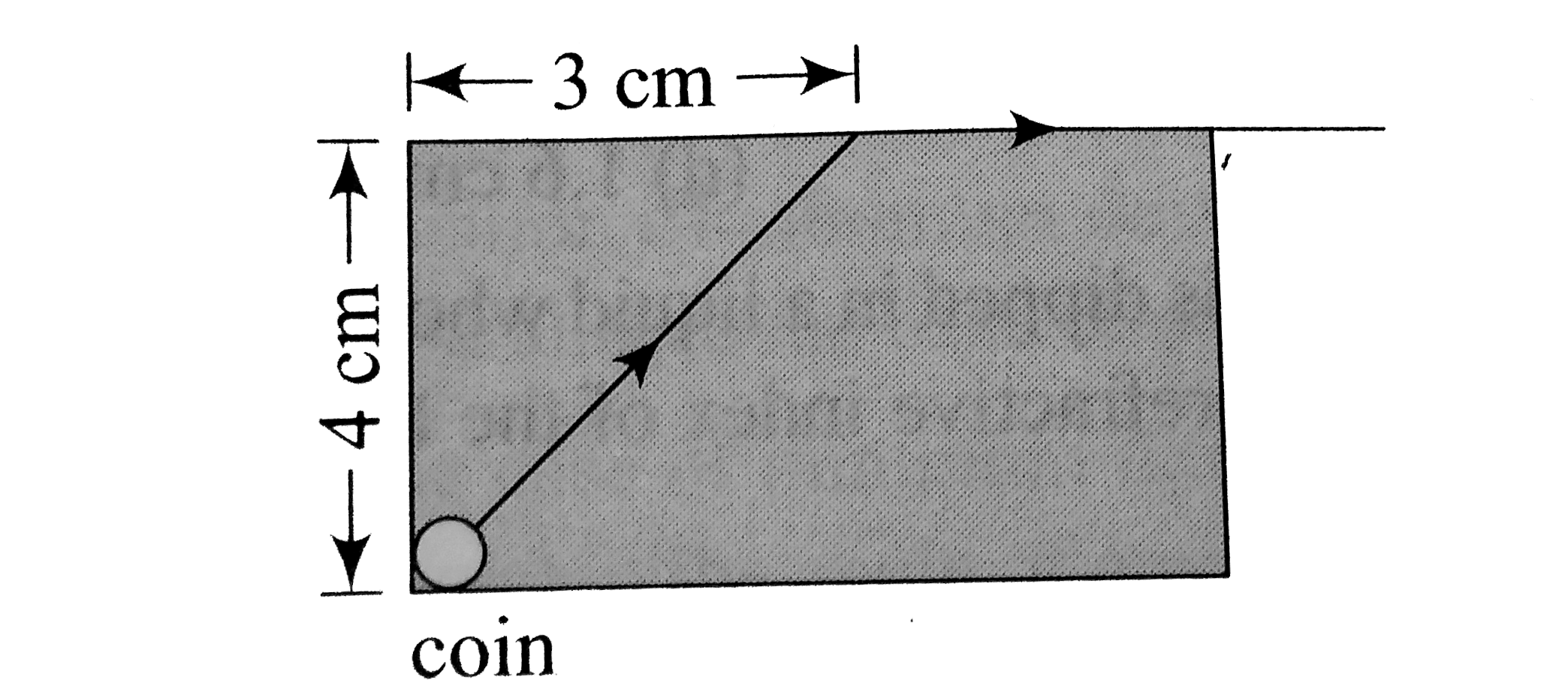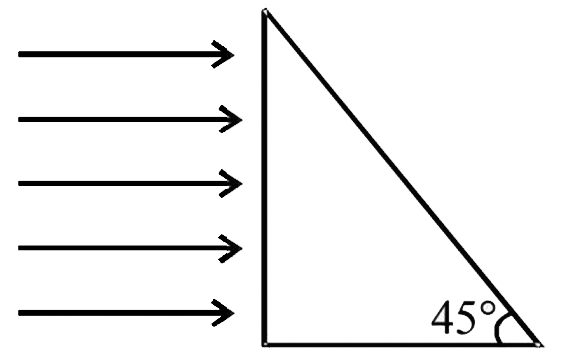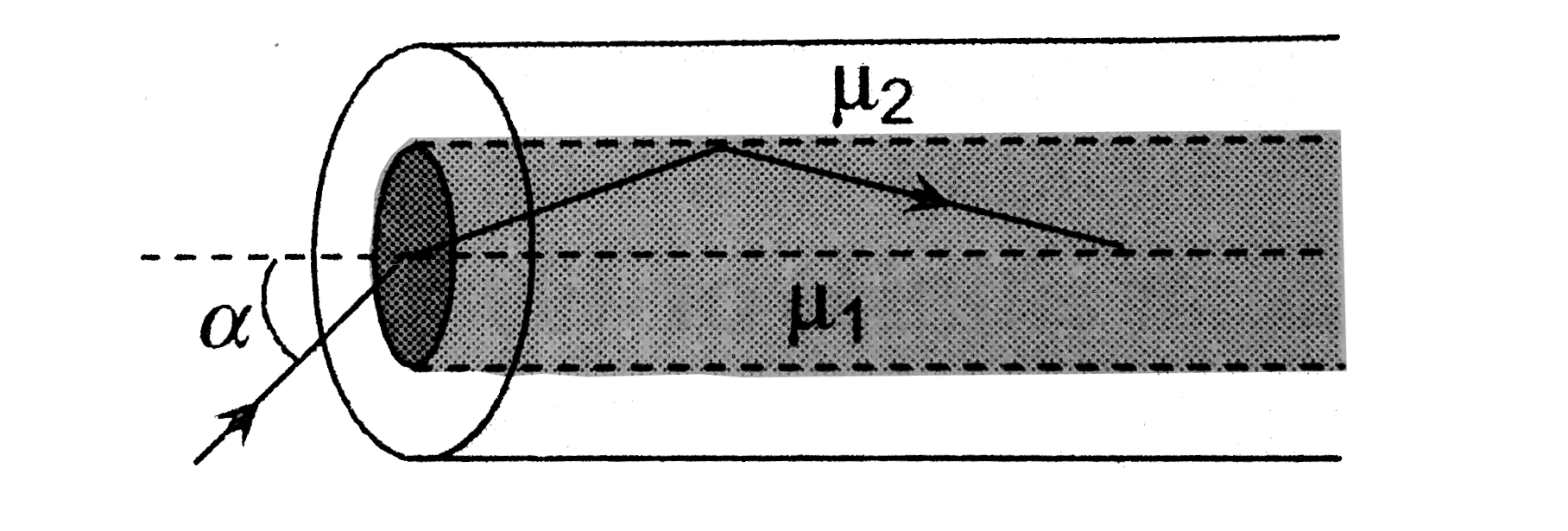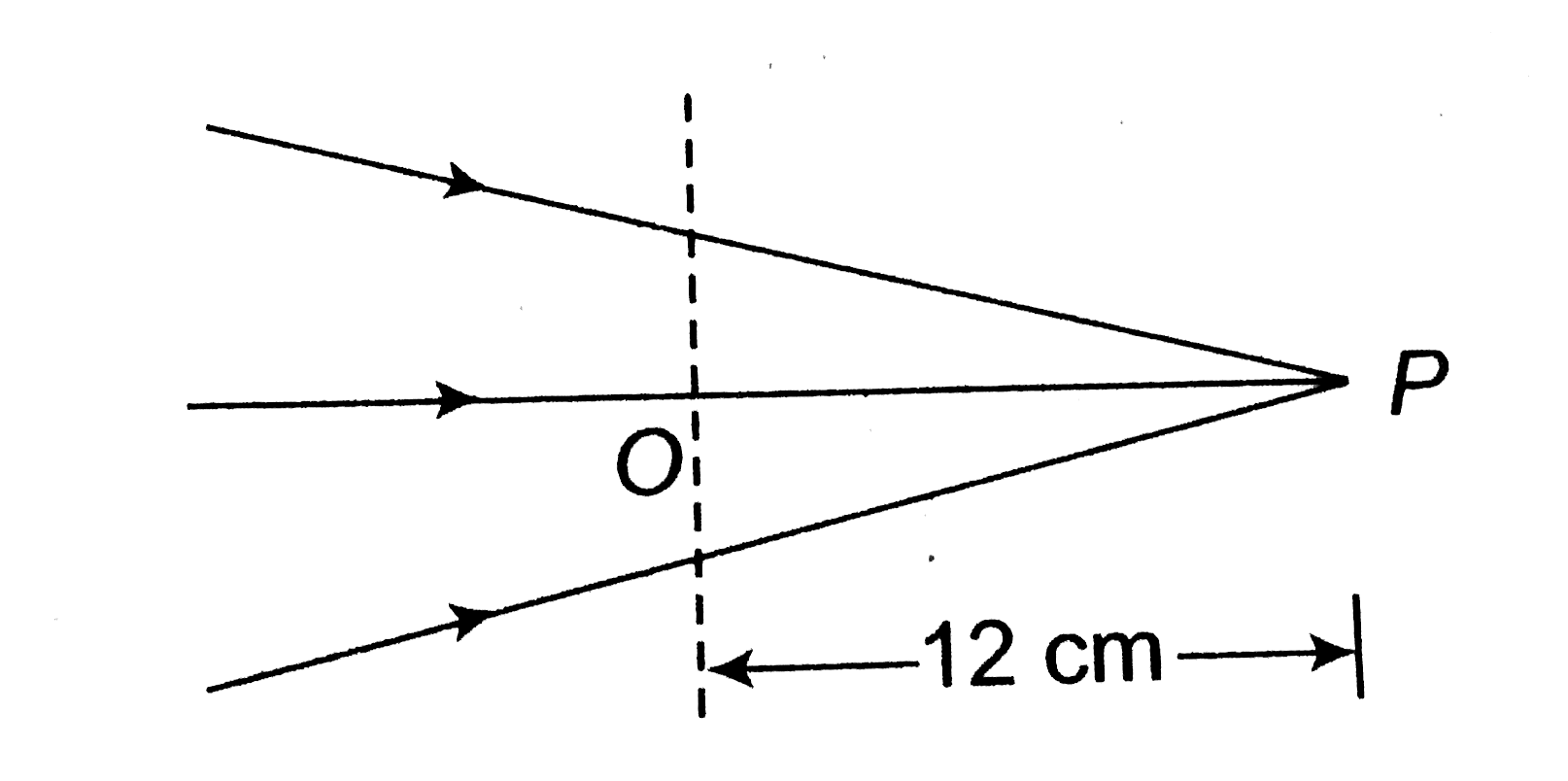Complete Solutions to AIPMT/NEET Questions of chapter GEOMETRICAL OPTICS of Class 12 book with complete answers and questions
| Class 12 | PHYSICS |
| Chapter | GEOMETRICAL OPTICS |
| A2Z | AIPMT/NEET Questions |
| Number Of Questions | 95 |
| Academic Year | 2023-24 |
Ray optics is valid when characteristic dimensions are
01:54View SolutionFor a prism of refractive index `1.732`, the angle of minimum deviation is equal to the angle of the prism. The angle of the prism is
04:03View SolutionFour lenses of focal length `+15 cm , +20 cm, +150 cm` and `+250cm` are available for making an astronomical telescope. To produce the largest magnification, the focal length of the eye-piece should be
01:44View SolutionTotal flux produced by a source of `1 cd ` is
01:16View SolutionLight wave enters from medium 1 to medium 2. Its velocity in `2^(nd)` medium is double from `1^(st)`. For total internal reflection the angle of incidence must be greater than
02:44View SolutionAn object is at a distance of `0.5m` in front of a plane mirrorr. Distance between the object and image is
01:20View SolutionIf the speed of light in vacuum is `C` `m//sec`, then the velocity of light in a medium of refractive index `1.5` is.
02:08View SolutionA person uses a lens of power `+3D` to normalise vision. Near point of hypermetropic eye is
03:01View SolutionA small air bubble in a sphere of glass with radius 4 cm appears to be 1 cm from the surface when observed along a diameter. Find the true position of the air bubble.
03:09View SolutionA convex lens is dipped in a liquid whose refractive index is equal to the refractive of the lens. Then its focal length will
03:03View SolutionAn equiconvex lens is cut into two halves along `(i) XOX^(')` and `(ii) YOY^(')` as shown in the figure. Let `f,f^(')f^('')` be the focal lengths of the complete lens, of each half in case `(i)`, and of each half in case `(ii)`, respectively
Choose the correct statement from the following
 04:25View Solution
04:25View SolutionThe sun makes `0.5^(@)` angle on earth surface. Its image is made by convex lens of `50 cm` focal length. The diameter of the image will be
02:24View SolutionThe chromatic aberration in lenses is due to
03:02View SolutionA glass prism has refractive index `sqrt(2)` and refracting angle `30^(@)` . One of the refracting surface of the prism is silvered. A beam of monchromatic light will retrace it path it its angle of incidence on the unsilvered refracting surface of the prism is
02:31View SolutionA beam of light composed of red and green ray is incident obliquely at a point on the face of rectangular glass slab. When coming out on the opposite parallel face, the red and green ray emerge form
03:42View SolutionA telescope has an objective lens of `10cm` diameter and is situated at a distance of one kilometre from two objects. The minimum distance between these two objects, which can be resolved by the telescope, when the mean wavelength of light is `5000 Å`, of the order of
03:22View SolutionA short linear object of length b lies along the axis of a concave mirror of focal length f at a distanee u from the pole of the mirror. The size of the image is approximately equal to
02:41View SolutionA person who can see things most clearly at a distance of `10 cm`. Requires spectacles to enable to him to see clearly things at a distance of `30 cm.` What should be the focal length of the spectacles ?
02:55View SolutionA transparent cube of `15 cm` edge contains a small air bubble. Its apparent depth when viewed through one face is `6 cm` and when viewed through the opposite face is `4 cm`. Then the refractive index of the material of the cube is
04:01View SolutionThe refractive indices of the material of the prism and liquid are `1.56` and `1.32` respectively. What will be the value of `theta` for the following refraction?
 03:18View Solution
03:18View SolutionThe angular resolution of a `10cm` diameter telescope at a wavelength `5000Å` is of the order
01:49View SolutionA fish looking up through the water sees the outside world contained in a circular horizon. If the refractive index of water is `(4)/(3)` and the fish is 12 cm below the surface, the radius of this circle is cm is
03:35View SolutionA concave lens and a convex lens have same focal length of `20 cm` and both put in contact this combination is used to view an object `5 cm` long kept at `20 cm` from the lens combination. As compared to object the image will be
03:28View SolutionThe focal length of field achromatic combination of a telescope is `90 cm` .The dispersive powers of lenses are `0.024` and `0.036` respectively .Their focal lengths will be-
03:20View SolutionA convex lens and a concave lens, each having same focal length of `25 cm`, are put in contact to form a combination of lenses. The power in diopters of the combination is
03:43View SolutionA microscope is focused on a mark on a piece of paper and then a slab of glass of thickness `3cm` and refractive index `1.5` is placed over the mark. How should the microscope be moved to get the mark in focus again ?
03:17View SolutionThe frequency of a light wave in a material is `2xx10^(14)Hz` and wavelength is `5000 Å`. The refractive index of material will be
02:38View SolutionA small coin is resting on the bottom of a beaker filled with a liquid. A ray of light from the coin travels up to the surface of the liquid and moves along its surface (see figure ).
How fast is the light travelling in the liquid ?
 04:08View Solution
04:08View SolutionTwo thin lenses of focal length `f_(1)` and `f_(2)` are in contact and coaxial. The power of the combination is
02:14View SolutionA boy is trying to start a fire by focusing sunlight on a piece of paper using an equiconvex lens of focal length `10cm`. The diameter of the sun is `1.39xx10^(9)m` and its mean distance from the earth is `1.5xx10^(11)m`. What is the diameter of the sun's image on the paper ?
03:46View SolutionA ray of light travelling in a transparant medium falls on a surface separating the medium from air at an angle of incidence of `45degree`. The ray undergoes total internal reflection. If n is the refractive in index of the medium with respect to air, select the possible value (s) of n from the following:
02:35View SolutionWhich of the following is not due to total internal reflection ?
03:31View SolutionA biconvex lens has a radius of curvature of magnitude `20cm`. Which one of the following options describes best the image formed of an object of height `2cm` place `30 cm` from the lens ?
03:41View SolutionA thin prism of angle `15^(@)` made of glass of refractive index `mu_(1)=1.5` is combined with another prism of glass of refractive index `mu_(2)=1.75`. The combination of the prism produces dispersion without deviation. The angle of the second prism should be
03:56View SolutionA converging beam of rays in incident on a diverging lens. Having passed through the lens the rays intersect at a point `15 cm` from the lens. If the lens is removed, the point where the rays meet, move `5 cm` closer to the mounting that holds the lens. Find the focal length of the lens.
05:35View SolutionWhen a biconvex lens of glass having refractive index `1.47` is dipped in a liquid, it acts as a plane sheet of glass. This implies that the liquid must have refractive index.
03:37View SolutionA ray of light is incident at small angle I on the surface of prism of small angle A and emerges normally from the oppsite surface. If the refractive index of the material of the prism is mu, the angle of incidence is nearly equal to
01:42View SolutionA concave mirrorr of focal length `f_(1)` is placed at a distance of `d` from a convex lens of focal length `f_(2)`. A beam of light coming from infinity and falling on this convex lens-concave mirrorr combination returns to infinity. The distance `d` must equal.
04:17View SolutionThe magnifying power of a telescope is `9.` When it is adjusted for parallel rays the distance between the objective and eyepiece is `20cm`. The focal lengths of lenses are
02:27View SolutionFor the angle of minimum deviation of a prism to be equal to its refracting angle, the prism must be made of a material whose refractive index
04:29View SolutionA rod of length 10 cm lies along the principal axis of a concave mirror of focal length 10 cm in such a way that the end closer to the pole is 20 cm away from it. Find the length of the image.
05:05View SolutionA plano-convex lens fits exactly into a plano-concave lens. Their plane surfaces are parallel to each other. If the lenses are made of different material of refractive indices `mu_(1)` and `mu_(2)` and R is the radius of curvature of the curved surface of the lenses, then focal length of the combination is
02:57View SolutionFor a normal eye, the cornea of eye provides a converging power of `40 D` and the least converging power of the eye lens behind the cornea is `20 D`. Using this information, the distance between the retina and the cornea eye lens can be estimated to be
03:15View SolutionIf the focal length of the objective lens is increased then
02:27View SolutionAngle of prism is `A` and its one surface is silvered. Light rays falling at an angle of incidence `2 A` on first surface return back through the same path after suffering reflection at second silvered surface. Refraction index of the material of prism is
04:20View SolutionThe refracting angle of a prism is `A` and refractive index of the material of the prism is `cos(A//2)`. The angle of minimum deviation is
04:12View SolutionTwo identical thin planoconvex glass lenses (refractive index `1.5)` each having radius of curvature of `20cm` are placed with their convex surfaces in contact at the centre. The intervening space is filled with oil of refractive index `1.7`. The focal length of the combination is
05:52View SolutionIn an astronomical telescope in normal adjustment a straight black line of length `L` is drawn on inside part of objective lens. The eye piece forms a real image of this line. The length of this image is `I`. The magnification of the telescope is
04:34View SolutionA beam of light consisting of red, green and blue colours is incident on a right angled prism, fig. The refractive indices of the material of the prism for the above red, green and blue wavelengths are 1.39, 1.44 and 1.47 respectively. The prism will `
 03:01View Solution
03:01View SolutionThe angle of incidence for a ray of light at a refracting surface of a prism is `45^(@)`. The angle of prism is `60^(@)`. If the ray suffers minimum deviation through the prism, the angle of minimum deviation and refractive index of the material of the prism respectively, are `:`
03:36View SolutionAn astronomical telesope has objective and eyepiece of focal lengths `40cm` and `4 cm` respectively. To view an object `200cm` away from the objective, the lenses must be separated by a distance `:`
03:39View SolutionTwo identical glass `(mu_(g)=3//2)` equiconvex lenses of focal length f are kept in contact. The space between the two lenses is filled with water `(mu_(w)=4//3)` . The focal length of the combination is
04:19View SolutionAn air bubble in a glass slab with refractive index `1.5` (near normal incidence) is `5 cm` deep when viewed from one surface and `3cm` deep when viewed from the opposite face. The thickness (in `cm)` of the slab is
03:47View SolutionA person can see objects clearly only when they lie between `50cm` and `400 cm` from his eyes. In order to increase the maximum distance of distinct vision to infinity, the type and power of the correcting lens, the person has to use, will be
03:16View SolutionA beam of light from a source `L` is incident normally on a plane mirror fixed at a certain distance `x` from the source. The beam is reflected back as a spot on a scale placed just above the source `L`. When the mirror is rotated through a small angle `theta`, the spot of the light is found to move through a distance `y` on the scale. The angle `theta` is given by `:`
03:42View SolutionA thin prism having refracting angle `10^(@)` is made of glass of refracting index `1.42`. This prism is combined with another thin prism of glass of refractive index `1.7`. This combination produces dispersion without deviation. The refracting angle of second prism should be `:`
03:26View SolutionAn object is placed at a distance of `40 cm` from a concave mirror of focal length `15 cm`. If the object is displaced through a distance of `20 cm` towards the mirror, the displacement of the image will be
04:13View SolutionA glass prism has refractive index `sqrt(2)` and refracting angle `30^(@)` . One of the refracting surface of the prism is silvered. A beam of monchromatic light will retrace it path it its angle of incidence on the unsilvered refracting surface of the prism is
02:31View SolutionAn astronomical refracting telescope will have large angular magnification and high angular resolution, when it has an objective lens of
02:13View SolutionThe resolving lime of healthy eye is about
01:48View SolutionA concave mirror of focal length `15 cm` forms an image having twice the linear dimensions of the object. The position of the object when the image is virtual will be
03:40View SolutionFour lenses of focal length `+15 cm , +20 cm, +150 cm` and `+250cm` are available for making an astronomical telescope. To produce the largest magnification, the focal length of the eye-piece should be
01:44View SolutionA ray of light is incident on the surface of plate of glass of refractive index `1.5` at the polarising angle. The angle of refraction of the ray will be
04:32View SolutionAn astronaut is looking down on earth's surface from a space shuttle at an altitude of `400 km. ` Assuming that the astronaut's pupil diameter is `5 mm` and the wavelength of visible light is `500 nm. ` The astronaut will be able to resolve linear object of the size of about .
03:51View SolutionIn an experiment to find focal length of a concave mirror, a graph is drawn between the magnitudes of (u) and (v). The graph looks like.
04:32View SolutionAn object is immersed in a fluid. In order that the object becomes invisible, it should
02:07View SolutionAn endoscope is employed by a physician to view the internal parts of body organ. It is based on the principle of
00:50View SolutionA telescope has an objective lens of focal length `200cm` and an eye piece with focal length `2cm`. If this telescope is used to see a 50 meter tall building at a distance of `2km,` what is the height of the image of the building formed by the objective lens?
03:16View SolutionThe apparent depth of water in cylindrical water tank of diameter `2R cm` is reducing at the rate of `x cm // min ` when water is being drained out at a constant rate. The amount of water drained in `c.c.` per minute is `(n_(1)=` refractive index of air, `n_(2)=` refractive index of water )
04:27View SolutionAn optical fiber consists of core of `mu_(1)` surrounded by a cladding of `mu_(2) lt mu_(1)`. A beam of light enters from air at an angle `alpha` with axis of fiber. The highest `alpha` for which ray can be travelled through fiber is
 06:26View Solution
06:26View SolutionIn refraction, light waves are bent on passing from one medium to the second medium, because, in the second medium
02:41View SolutionA wire mesh consisting of very small squares is viewed at a distance of `8cm` through a magnifying converging lens of focal length `10 cm`, kept close to the eye. The magnification produced by the lens is:
01:38View SolutionA lens is made of flint glass (refractive index `=1.5`). When the lens is immersed in a liquid of refractive index `1.25` , the focal length:
02:58View SolutionIn a compound microscope, the focal length of the objective and the eye lens are `2.5 cm` and `5 cm` respectively. An object is placed at `3.75cm` before the objective and image is formed at the least distance of distinct vision, then the distance between two lenses will be `( i.e.` length of the microscope tube )
05:09View SolutionA thin glass (refractive index 1.5) lens has optical power of `-5D` in air. Its optical power in a liquid medium with refractive index 1.6 will be
03:20View SolutionA fish looking up through the water sees the outside world contained in a circular horizon. If the refractive index of water is `(4)/(3)` and the fish is 12 cm below the surface, the radius of this circle is cm is
03:35View SolutionA beam of light propagating in medium A with index of refraction `n(A)` passes across an interface into medium B with index of refraction `n(B)`. If `v(A)` and `v(B)` are the speeds of light in A and B respectively. Then which of the following is true?
02:00View SolutionA microscope is focused on a coin lying at the bottom of a beaker. The microscope is now raised up by `1 cm`. To what depth should the water be poured into the beaker so that coin is again in focus ? (Refractive index of water is `4//3`)
03:35View SolutionA diver in a swimming poole wants to signal his distress to a person lying on the edge of the pool by flashing his water proof flash light
02:50View SolutionA ray of monochromatic light is incident on one refracting face of a prism of angle `75^(@)`. It passes through the prism and is incident on the other face at the critical angle. If the refractive index of the material of the prism is `sqrt(2)`, the angle of incidence on the first face of the prism is
03:44View SolutionA combination of two thin lenses with focal lengths `f_(1)` and `f_(2)` respectively forms and image of distant object at distance `60cm` when lenses are in contact. The position of this image shifts by `30 cm` towards the combination when two lenses are separated by `10 cm`. The corresponding values of `f_(1)` and `f_(2)` are
05:08View SolutionA thin made of glass of refractive index `1.5` has a front surface `+11 D` power and back surface `-6D` . If this lens is submerged in a liquid of refractive index `1.6`, the resulting power of the lens is
04:13View SolutionA thin prism `P_(1)` with angle `4degree` and made from glass of refractive index 1.54 is combined with another thin prism `P_(2)` made from glass of refractive index 1.72 to produce dispersion without deviation. The angle of the prism `P_(2)` is
01:39View SolutionFigure given below shows a beam of light converging at point `P.` When a convex lens of focal length `16cm` is introduced in the path of the beam at a place `O` shown by dotted line such that `OP` becomes the axis of the lens, the beam converges at a distance `x` from the lens. The value `x` will be equal to
 04:03View Solution
04:03View SolutionAn equilateral prism is placed on a horizontal surface. A ray PQ is incident onto it. For minimum deviation `
 00:33View Solution
00:33View SolutionIn a laboratory four convex lenses `L_(1), L_(2), L_(3)` and `L_(4)` of focal lengths `2,4,6` and `8 cm` respectively are available. Two of these lenses form a telescope of length `10 cm` and magnifying power 4 . The objective and eye lenses are
02:19View SolutionThe average distance between the earth and moon is `3.86xx10^(4)km`. The minimum separation between the two points on the surface of the moon that can be resolved by a telescope whose objective lens has a diameter os `5 m` with `lambda=6000 Å` is
03:55View SolutionOne side of a glass slab is silvered as shown. A ray of light is incident on the other side at angle of incidence `i=45^(@)` . Refractive index of glass is given as `1.5`. The deviation of the ray of light from its initial path when it comes out of the slab is
 02:55View Solution
02:55View SolutionA double convex lens, lens made of a material of refractive index `mu_(1)`, is placed inside two liquids or refractive indices `mu_(2)` and `mu_(3)`, as shown. `mu_(2)gtmu_(1)gtmu_(3)`. A wide, parallel beam of light is incident on the lens from the left. The lens will give rise to
 05:26View Solution
05:26View SolutionThe graph shows variation of `v` with change in `u` for a mirrorr. Points plotted above the point `P` on the curve are for values of `v`
 02:30View Solution
02:30View SolutionTwo similar planoconvex lenses are combined together in three different ways as shown in the adjoining figure. The ratio of the focal lengths in three cases will be
 01:58View Solution
01:58View SolutionA point object `O` is placed in front of a glass rod having spherical end of radius of curvature `30cm`. The image would be formed at
 03:39View Solution
03:39View SolutionA `2.0 cm` tall object is placed `15 cm` in front of concave mirrorr of focal length `10 cm`. The size and nature of the image will be
03:58View SolutionA person can see clearly only up to a distance of `25 cm`. He wants to read a book placed at a distance of `50cm`. What kind of lens does he require for his spectacles and what must be its power ?
03:00View SolutionIn a simple microscope of focal length `5 cm` final image is formed at `D`, then its magnification will be
02:02View Solution
AIPMT/NEET Questions questions and complete solutions for chapter GEOMETRICAL OPTICS of A2Z PHYSICS (HINGLISH) of Class 12